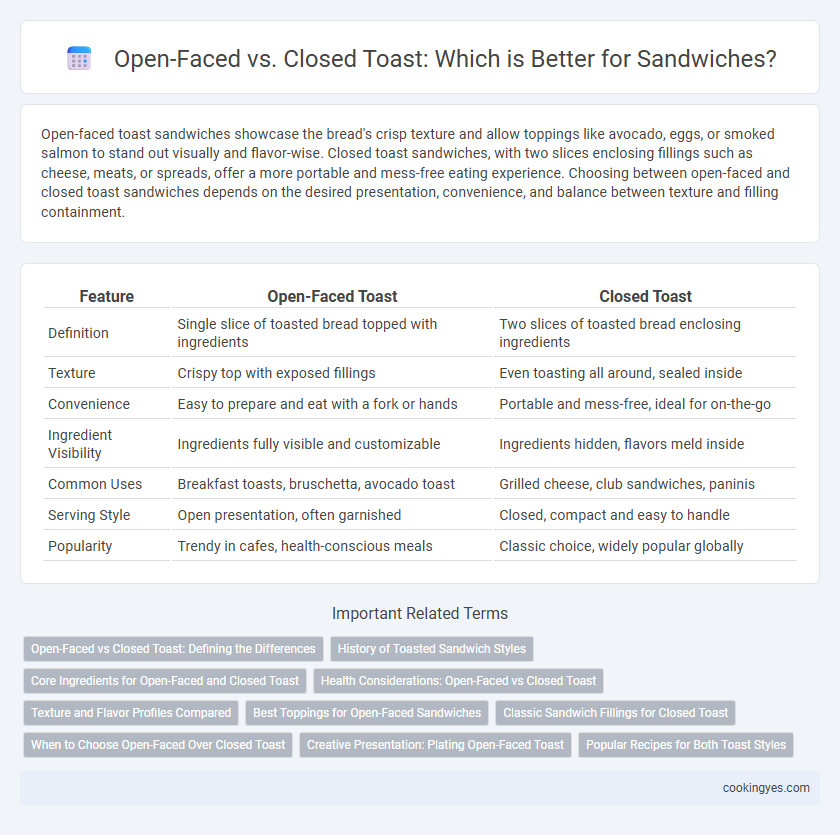Open-faced toast sandwiches showcase the bread's crisp texture and allow toppings like avocado, eggs, or smoked salmon to stand out visually and flavor-wise. Closed toast sandwiches, with two slices enclosing fillings such as cheese, meats, or spreads, offer a more portable and mess-free eating experience. Choosing between open-faced and closed toast sandwiches depends on the desired presentation, convenience, and balance between texture and filling containment.
Table of Comparison
| Feature | Open-Faced Toast | Closed Toast |
|---|---|---|
| Definition | Single slice of toasted bread topped with ingredients | Two slices of toasted bread enclosing ingredients |
| Texture | Crispy top with exposed fillings | Even toasting all around, sealed inside |
| Convenience | Easy to prepare and eat with a fork or hands | Portable and mess-free, ideal for on-the-go |
| Ingredient Visibility | Ingredients fully visible and customizable | Ingredients hidden, flavors meld inside |
| Common Uses | Breakfast toasts, bruschetta, avocado toast | Grilled cheese, club sandwiches, paninis |
| Serving Style | Open presentation, often garnished | Closed, compact and easy to handle |
| Popularity | Trendy in cafes, health-conscious meals | Classic choice, widely popular globally |
Open-Faced vs Closed Toast: Defining the Differences
Open-faced toast features a single slice of bread topped with ingredients, offering a lighter, crispier texture and more pronounced flavors from the toppings. Closed toast, commonly known as a sandwich, involves two slices of bread encasing the fillings, providing a more compact and portable meal. The primary difference lies in presentation and texture, with open-faced toast allowing for more visually appealing and customizable toppings, while closed toast emphasizes convenience and structural integrity.
History of Toasted Sandwich Styles
The history of toasted sandwich styles reveals that open-faced toast sandwiches date back to early European culinary traditions where simplicity and showcasing toppings were key. Closed toast sandwiches gained popularity during the 20th century with the invention of the sandwich press, allowing ingredients to meld and melt efficiently. Both styles highlight cultural preferences and technological advances in sandwich preparation over time.
Core Ingredients for Open-Faced and Closed Toast
Open-faced sandwiches typically feature a single slice of bread topped with core ingredients like fresh vegetables, sliced meats, cheeses, and spreads, allowing for distinct flavor combinations and a visually appealing presentation. Closed toast sandwiches, or traditional sandwiches, consist of two slices of bread encasing core ingredients such as deli meats, cheeses, leafy greens, and condiments, which create a compact, handheld meal ideal for on-the-go consumption. Both styles emphasize high-quality bread selection, with artisan or whole grain bread enhancing texture and taste in open-faced options, while sturdy sandwich bread ensures structural integrity in closed toast varieties.
Health Considerations: Open-Faced vs Closed Toast
Open-faced sandwiches typically contain fewer calories and less fat due to the single slice of bread, making them a healthier option for weight management and digestion. Closed toast sandwiches, often packed with more fillings and double the bread, can increase carbohydrate and calorie intake, potentially impacting blood sugar levels and heart health. Choosing whole-grain bread in either style enhances fiber content, supporting better cholesterol control and sustained energy release.
Texture and Flavor Profiles Compared
Open-faced toast sandwiches offer a crisp, airy texture with enhanced surface caramelization, intensifying flavors through direct exposure to heat and toppings. Closed toast sandwiches create a warm, soft interior with a slight crunch on the outer crust, locking in moisture and blending flavors for a harmonious bite. The choice between open-faced and closed impacts texture contrast and flavor depth, influencing the overall sandwich experience.
Best Toppings for Open-Faced Sandwiches
Open-faced toast provides an ideal base for fresh, vibrant toppings like avocado, smoked salmon, and heirloom tomatoes, allowing each ingredient's texture and flavor to stand out. Cream cheese, ricotta, and hummus add creamy layers that complement the crisp bread without overpowering it. Fresh herbs like basil and dill, along with a drizzle of olive oil or balsamic glaze, elevate open-faced sandwiches into visually appealing and gourmet meals.
Classic Sandwich Fillings for Closed Toast
Closed toast sandwiches preserve moisture and create a compact texture ideal for classic fillings like ham, cheese, and tomato. The sealed bread prevents ingredients from falling out, enhancing portability and ease of eating. Popular closed toast combinations also include turkey with cranberry sauce and peanut butter with jelly for nutritious, balanced options.
When to Choose Open-Faced Over Closed Toast
Open-faced toast sandwiches excel when showcasing fresh, vibrant toppings like avocado, smoked salmon, or heirloom tomatoes, allowing flavors and textures to stand out without being confined by a top slice. Opt for open-faced toast when quick preparation and visually appealing presentation are priorities, especially in casual or brunch settings. Closed toast sandwiches suit situations requiring portability and ingredient containment, but open-faced versions enhance taste exposure and are ideal for lighter, ingredient-focused meals.
Creative Presentation: Plating Open-Faced Toast
Open-faced toast offers a visually striking presentation by showcasing vibrant ingredients atop a crisp bread base, enhancing the sensory appeal of sandwiches. The arrangement of colorful vegetables, spreads, and proteins can be artfully layered to create an inviting and appetizing dish that highlights texture and freshness. Creative plating techniques, such as garnishing with microgreens or drizzling balsamic glaze, elevate the open-faced toast to a gourmet experience, emphasizing both flavor and aesthetics.
Popular Recipes for Both Toast Styles
Open-faced toast sandwiches such as avocado toast topped with radishes and poached eggs or smoked salmon with cream cheese showcase vibrant flavors and visually appealing presentations. Closed toast varieties like classic grilled cheese, club sandwiches, and BLTs offer hearty combinations with melted cheeses, crispy bacon, and fresh vegetables sealed between two slices of toasted bread. Popular recipes for both styles emphasize the balance of texture, taste, and ingredient freshness to cater to diverse preferences and meal occasions.
Open-Faced vs Closed Toast for Sandwiches Infographic

 cookingyes.com
cookingyes.com